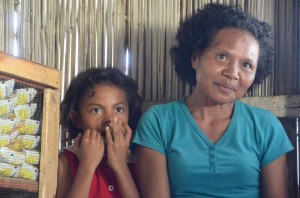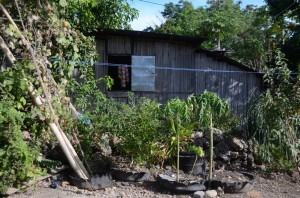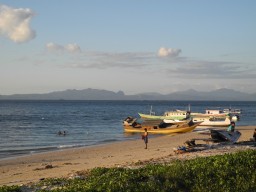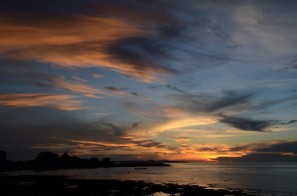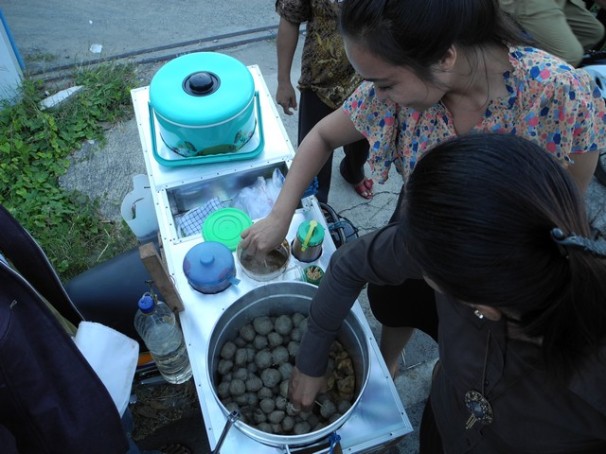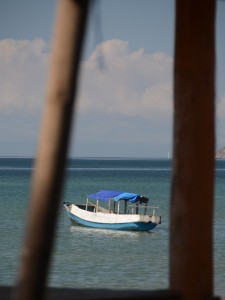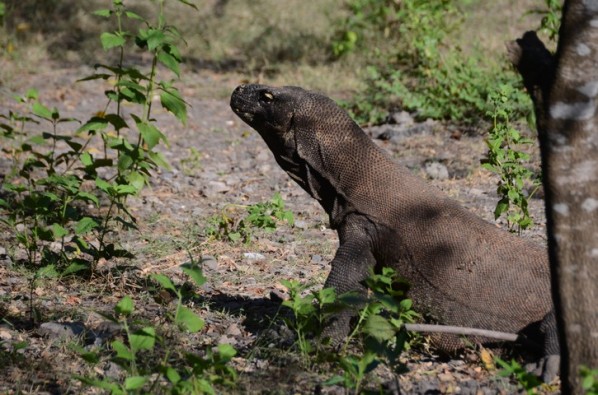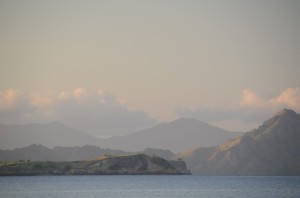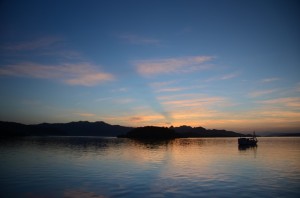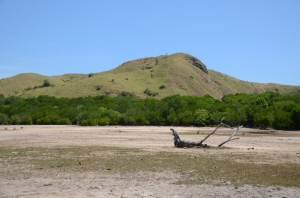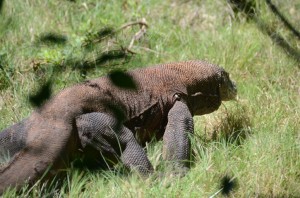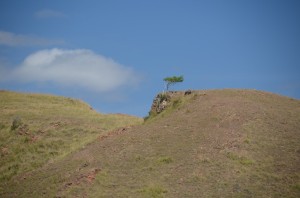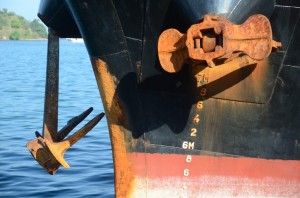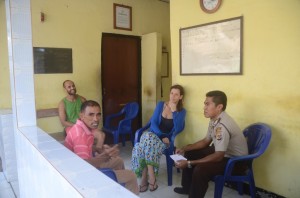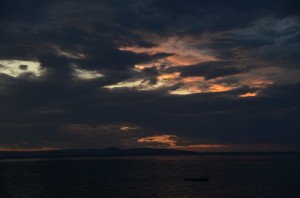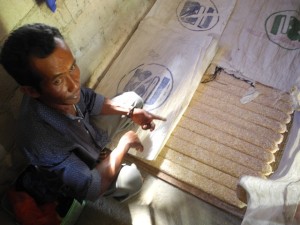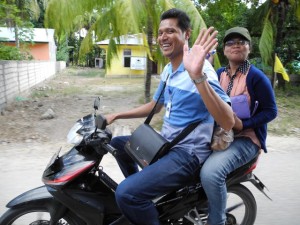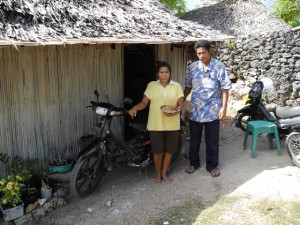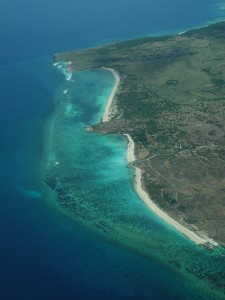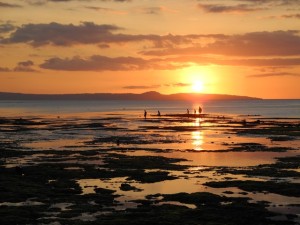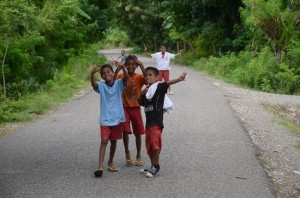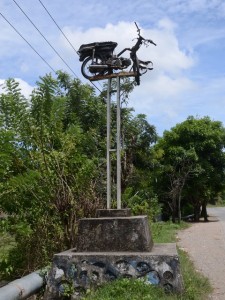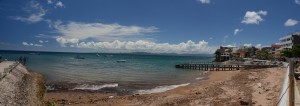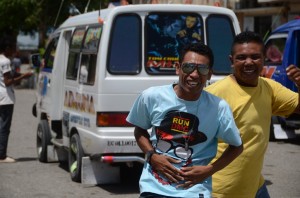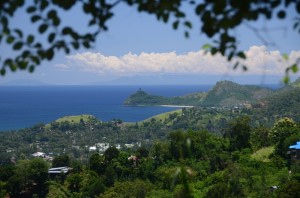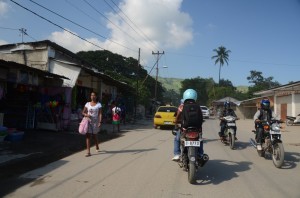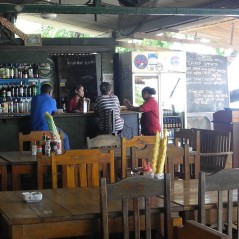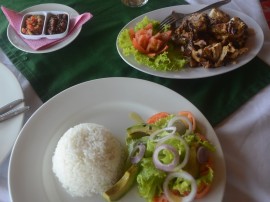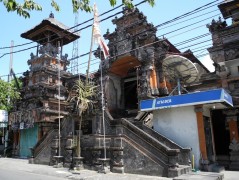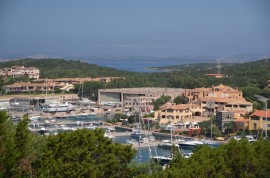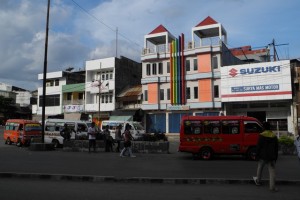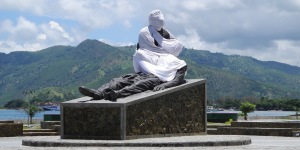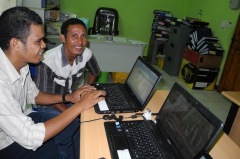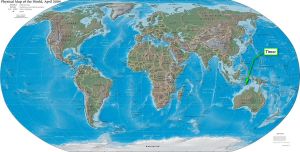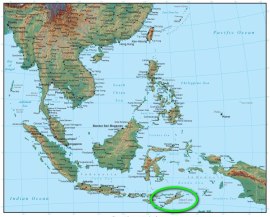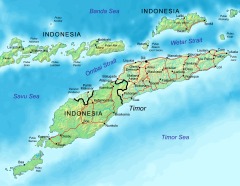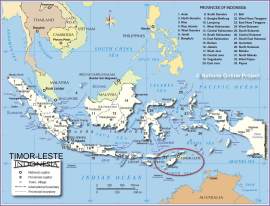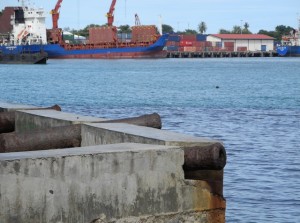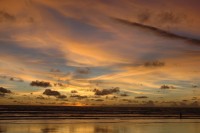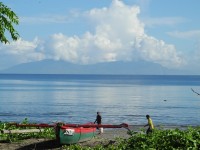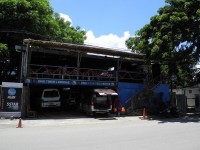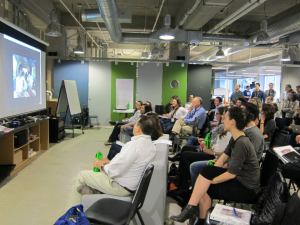Archive
One in a Few Billion.
I’ve written a few blogs about my experience as a Kiva Fellow in Timor, but I haven’t written directly about a typical borrower in this very poor region. So as I wrap up this fellowship with Kiva, I’m taking this opportunity to fill that gap.
The borrower you’re about to meet lives within the city limits of Kupang on the western tip of Timor. Kupang is the provincial capital of Nusa Tenggara Timur which includes the western half of Timor, the islands of Flores, Sumba, Alor, Rinca, Komodo and 560 other small islands. NTT is the poorest province in Indonesia, but it is a beautiful place. Jagged mountain skylines (mostly volcanic, though Timor is not) are bounded by coral reefs, isolated and deserted beaches, and rich turquoise seas.
The Kiva micro-finance partner in Kupang, Tanaoba Lais Manekat (“Serving With Love” in the local Dawan language) has been operating since 1995. TLM has grown to 30 branches operating on six islands serving 7,000 clients. At this writing there are 410 active Kiva loans which will expand to about 700 as TLM uses all of the loan capacity now available to them. The average Kiva loan is about $650 and is repaid in just over two years.
Blandina has been a TLM/Kiva client for several years. She is 46 and raising six children spanning the ages of 6 to 18. She exemplifies someone who was at risk of slipping into poverty and was unfortunate enough to find herself there.
Ten years ago she would not have considered herself poor. Although they lived in a humble house, her husband, Oktovianus, worked as a mason. Together with her income as a sales clerk, and a small goods business in the local market they were able to support their family.
But a few years ago Oktovianus passed away after a long illness which drained the family savings and forced them to sell their home. Blandina was left with nothing and needed to support her children by herself. Her own illness forced her to leave her job as a sales clerk, so to meet expenses she went door to door washing clothes.
The earnings from washing just wasn’t enough, so she began to generate a bit more income by opening a kiosk business from the home she now rents. It’s a small operation selling home-made snacks and baked goods (her spicy fried corn is especially yummy), instant noodles, toiletries, staples like salt and sugar, candies and other items. She began with her own capital and borrowed about $300 through TLM and Kiva to increase her stock and build a larger customer base.
After housing and feeding her children, keeping them in school has been Blandina’s primary concern. She has a unique savings system where money earned from each of her activities is put in a different colored box for different expenses – one of these is for tuition. She also has savings in TLM’s deposit program.
She recently took out her fifth loan and will be using the $400 to expand her income activity by buying piglets to raise and fatten for re-sale.
The income from her various businesses has allowed her to meet her goal to keep her children in school. Unfortunately, her oldest son recently graduated from high school and is not able to attend university – he’s working as a fare collector on one of the local mini-buses to help with family expenses.
Blandina is hoping that continuing support from TLM and Kiva’s lenders will help her build a better future for her other children. She is certainly working hard to make that happen.
If you haven’t looked into Kiva, you might take this opportunity to do so. It’s an easy method to help the neediest people directly through Kiva’s partners worldwide. It has been proven for many years that micro-finance works – micro-loans enable people to help themselves. It would be great if you could make a loan for as little as $25 to one of the billions of poor people like Blandina throughout the world.
Go to Kiva.org and meet someone like Blandina. Loan them a few bucks. It isn’t tax deductible because you get it back.
More pictures of NTT here: NTT Photos
Postcard from the Lesser Sunda Islands
————————–
Here are some random photos from some of the islands of the Lesser Sunda group: Indonesian Timor, Sabu, Rote, Flores, Rinca, and Komodo.
There are many more photos to see on flickr. Click HERE.
Here’s the map I promised. The Lesser Sunda Islands make up the Indonesian province of Nusa Tenggara Timur (East Southeast Islands):
Artificially Sweetened Development
Usually when I’ve been in places that I declare to be “artificial” I am thinking of a Disney theme, or a place like Cabo San Lucas or Cancun – southern California or Florida transported to Mexico – a place which bears little resemblance to what it would be like if it weren’t for the tourist dollars it was created to attract. Of course, Las Vegas is the archetype for turning a desert into a sweet water oasis, of sorts.
Shopping malls are artificial in that they are sterile replacements for shopping streets. Modern shopping areas have turned most American cities into a Warhol-like canvas of indistinguishable images in slightly different hues. Show me a Walmart and there’s a Taco Bell not far away.
Dili, the capital of Timor-Leste, is an artificial place, but in a different way. The city (and much of the country) was destroyed after the rampage of pro-Indonesian militias following the 1999 independence referendum. (This followed a period of brutal repression highlighted by a concerted effort on the part of the “international community” to look the other way. Most notably Australia, the only country in the world to officially recognize Indonesia’s sovereignty, by a thirst for oil and gas in Timor’s offshore fields. And by the US in the post-Vietnam cold war era where Suharto was just about the last regional dictator available to support.)
Post-independence civil strife in the middle of the ‘naughties didn’t help. Today there are only a few remaining scars of that time – a few scorched buildings – and it is a fairly bustling place of a few hundred thousand inhabitants.
What exists today would not exist without the huge influx and efforts of UN peace keeping forces, NGO’s and aid agencies of every stripe and nationality. There is not a school or public building without a flag or plaque commemorating the foreign entity that paid for it. Some of it was direct aid like the central post office – paid for by South Korea. More recently large commercial investment has appeared. The first shopping mall and cinema (just opened late 2012) was built by Singapore developers. (You can tell it’s Singaporese because guests going from the ground floor reception desk to the elevators for the upstairs hotel must walk through the shopping center. And some rooms have lovely balconies with windows either facing a blank wall, or blocked by billboards.)
I’m sure there was a great deal of planning on the part of those responsible for the rebuilding, and I don’t suggest that it was not noble, humanitarian, right, and helpful to the government and people of Timor-Leste to have done this. But it is certain that what exists here today would not have sprouted from local, organic development.
Any cultural expression is limited to a few places where traditional woven cloth (tais), baskets and carvings are sold. Notable among them is the Alola Foundation created to raise awareness of sexual violence against women and girls as a result of the militia rampages of 1999 www.alolafoundation.org. A new “Timorese Resistance Archive and Museum” (paid for by Portugal and Macau) relates the long struggle for independence. (A little ironic when you consider that Timor-Leste and Macau were Portuguese colonies for over 400 years.)
The consequences of this development are a little strange, though not immediately apparent in a quick visit. For the most part, tourists are rare, and what exists in Dili exists to support the international workforce. Supply of services is highly skewed toward them and their expense accounts.
When UN workers first arrived, there was no place for them to stay, and they were lodged on ships moored just offshore. Building “tourist infrastructure” is one of the areas where aid was and is applied. And though priced at international rates, it is not of high standard. In the poorest country in one of the poorest regions of the world, my room cost a whopping $850 per month (a slightly larger room with a chair, sofa and table was $400 more). Similar lodging on the Indonesian side of the island costs less than 1/3 of that. The main difference being the lack of a large foreign aid workforce.
The UN left in December of 2012. I wasn’t there before they pulled out, so I can’t say how different it is today, but all of the beach side tourist restaurants are running at idle. There are few customers.
From the viewpoint of someone assigned there, even for just a brief period as I was, it was very nice to find the Chinese-owned grocery store shelves filled with imported goods – mostly from Portugal (great sardines and olives). And I did find Skippy peanut butter, both Smooth and Crunchy.
One of the things I pictured in my mind before arriving here was wonderful grilled seafood. And there was a lot of fresh fish being pulled out of the sea and for sale along the beachfront road. But it was never on ice, often in the sun, and as the day wore on, the smell of spoiling fish filled the air. I never had a really good piece of fish in Dili, and I think most of what I got was a frozen import. You could even get five varieties of imported Portuguese dried bacalau in one of the markets.
For a short jaunt from town on a weekend I could often be found riding my motorbike 10km east along the beach to “the Jesus statue” – a 27m tall copy of the one in Rio – and back.
Stopping for lunch in one of the beach bodegas usually meant a pretty long wait if I ordered anything more exotic than nasi goreng (fried rice). The cook didn’t keep much food on hand – it would likely go to waste for a lack of customers. She had to send out to buy anything I ordered. The chicken was a good bet to be fresh since it came back from the market still clucking.
About 70% of the population of Timor-Leste lives on less than $2.50 per day. Coincidentally, an ice cream cone at the new mall costs $2.50. The lunch special at The One More Bar is $5.00. Most lunches out cost $8-10, though the $6.50 buffet at the City Cafe was the best deal. (I think The OMB was named with the intention of prompting you to order “one more,” but I interpreted it as “just another bar.”)
I have no survey data to support this statement, but I think I am safe in saying that 99.5% of the local population cannot participate in this economy. This is the symptom of big money aid. It doesn’t address the bulk of the population. It papers over things and gives a false sense (not in all ways) that progress has been made when, in fact, most people have been left behind.
It’s the Law of Unintended Consequences.
Good time for a Kiva plug (www.kiva.org). The reason I was in Dili was to work with Kiva’s micro-finance partner Tuba Rai Metin (tubaraimetin.com) to improve their reach to the people left behind. I suppose my time was well spent since TRM will soon be offering Kiva loans in all 13 national districts (before they were only offered in 2), and their available fundraising limit with Kiva was more than doubled. The next time you make a Kiva loan, be sure to look for borrowers in Timor-Leste.
Splitting my time as a Kiva Fellow between Timor-Leste and west Timor, Indonesia, I had two options for moving to Kupang in the west. Either a horrendous 12 hour bus ride, or a flight to Bali and a flight back to Kupang. A couple of days R&R on Bali sounded like a good plan, so I booked a hotel in Sanur, an area I hadn’t stayed in before.
Bali is a different definition of artificial. Perhaps it’s just over-developed. I don’t know where the development dollars are from, but there were (and are) a lot of them. The whole southern end of the island is one traffic jam in streets full of foreign shops and throngs of paradise seeking vacationers and the people to support this industry. Yucch.
The “real” Bali is to be found inland or along the coastline well away from over-developed Denpasar, Kuta, Legian and Sanur. But does “the real” (old) Bali still exist? Doubtful. Maybe just a shadow of it.
Whether or not it is, I don’t know, but the development seems more home grown here. Even with all the tourist mod-cons and brand name shops, the building seems more in line with Balinese ideas.
Bali was probably a nice hideaway at one time, but it is a perfect example of why you should keep your mouth shut when you find someplace nice.
I ran into another aspect of this last year in Sardinia. The northeastern coast, La Costa Smerelda, was scrub land picked up by the Aga Khan in the 1960’s for next to nothing. He developed it into a characterless resort town, touted it, and today it’s a destination for the rich, the famous, the wannabies, and cyclists with only one coastal road to choose from.
But I was also curious to see how the other, other half lives, and to check out the advertised splendor of the scenic coast. I was really disappointed. It’s scrub land. There are far more beautiful places in Sardinia than that (and I’m not going to tell you where).
It just shows you what good marketing and the general desire of humans to gather into amorphous clumps, dress alike, drink beer and proclaim their superiority can do, though I guess the clientele there has a better claim on the latter than the rest of us.
So I was really interested to see what Kupang would be like – only 175 miles (280 km) as the crow flies from Dili. There are no tourist brochures touting it as a destination. I’ve only been here about ten days, but I can say it is real. There’s nothing in Kupang that I can interpret as put on, or existing only to serve a foreign audience. OK, there’s Teddy’s Bar down on the water, but it ain’t much.
Kupang is a noisy, bustling place. It is the business center and capital of Nusa Tenggara Timur – the poorest province in Indonesia. The nicest hotel in town is rather unremarkable and worn. The budget places are a little scary. The only foreign restaurant chain I’ve found is KFC, and there are far fewer foreigners around, though almost all of those are aid workers. There are many little snack places, and the restaurants are patronized by local people and families – a very rare sight in Dili.
You can get fresh fish in the supermarket, on ice, and you can even get Skippy (smooth only). The very nice Borneo Bakery sells local product, not imitations of perceived foreign tastes. As an added bonus, the mosquitoes seem to be more plump and juicy and crackle more dramatically when hit with my zapper.
Missing from the landscape are the white Toyota Land Cruisers with UN or other logos on the doors and hood, careering around town with little regard for anyone else.
A surprising absence in traffic are taxis. They were everywhere in Dili and always honking to get attention. I’ve seen just a couple in Kupang, but the population of motorbikes is higher here, and the traffic worse. Taxi’s must have sprouted in Dili to serve the needs of the foreigners. The normal city public transport in both places are mini-buses – mikrolets in Dili; bemos in Kupang. (The “bus, coach & minibus” section of my phrase book offers the helpful, “You’re on my foot.”)
So, as I dig deeper into the place over the next few weeks, I’ll monitor how I feel about reality. I’ll have the chance to do that while I’m working with Kiva partner Tanaoba Lais Manekat (ytlm.org). My main task will be to perform a “borrower verification” – meeting with 10 current Kiva-TLM borrowers spread from Sabu to Niki-Niki. And I’ll be discussing ways TLM can take advantage of Kiva’s lender base to improve their reach to the poorest of the poor.
Standing Firmly on the Ground
An Unstable Foundation
In western mythology the phoenix, rising from its own ashes, represents cyclical extinction and regeneration; death and re-birth. Human stories lack the mythical qualities of the tales they inspire.
“On 30 August 1999, in a UN-supervised popular referendum, an overwhelming majority (78.5%) of the people of Timor-Leste voted for independence from Indonesia. However, in the next three weeks, anti-independence Timorese militias – organized and supported by the Indonesian military – commenced a large-scale, scorched-earth campaign of retribution. The militias killed approximately 1,400 Timorese and forcibly pushed 300,000 people (1/3 of the population) into western Timor as refugees. Most of the country’s infrastructure, including homes, irrigation systems, water supply systems, and schools, and nearly 100% of the country’s electrical grid were destroyed. On 20 September 1999, Australian-led peacekeeping troops deployed to the country and brought the violence to an end.” CIA Factbook – parenthetical comments and emphasis mine.
In 2000, Save the Children hired Angelo Soares to work as coordinator of their Children Youth Development Program (CYDP) as part of the re-building effort in Timor-Leste. Timorese by birth, he had been educated in Indonesia in agricultural development and worked for the government there for 10 years.
When Save the Children opened a micro-credit program in July of 2001, they asked Angelo to join that program. The micro-credit program was transferred to Catholic Relief Services in January 2002, and on May 13 “Tuba Rai Metin” (“Standing Firmly on the Ground” in the local Tetum language) became a legal entity registered with the NGO Forum. CRS continued support to TRM over the next four years with loan capital, technical assistance and grants.
Timor-Leste was internationally recognized as an independent state on 20 May 2002, 27 years after the Indonesian occupation began.
Angelo began as a field loan officer, and he rose to be a Branch Manager in 2004. By 2006 he had become an Area Manager.
An Uneven Recovery
Unfortunately, 2006 would be a year of turmoil, too.
“East Timor’s capital, Dili, descended into chaos in April and May 2006, when the prime minister, Mari Alkatiri, fired almost half the country’s soldiers for striking. The fired soldiers, who had protested against low wages and alleged discrimination, then began rioting, and soldiers loyal to the prime minister started battling them. Soon the violence had spread to the police force and the civilian population, causing about 130,000 to flee their homes to avoid the bloodshed. Australian troops were called in to control the unrest. On June 26, Prime Minister Alkatiri resigned in an effort to stop the country’s disintegration.” Infoplease.com.
Angelo remembers the date well. It was May 26 when his home was ransacked and destroyed. His family lost everything. They fled to live in nearby Motael Church with 500 other scared people. Other churches and schools across the city along with the airport filled with refugees by the thousands. They remained for two weeks until calm returned. Like the rest of his neighbors, Angelo and his family were starting from zero.
The senior manager of TRM fled to Australia “for 12 days”, but a month later he sent his resignation letter to the board and never returned. Angelo was now in charge of what had been the 5th largest of 15 micro-finance institutions (MFI’s) in the country. Thirteen of them were now closed because they lost their assets. But TRM still had physical and financial assets, loans outstanding, and clients wanting to stay in business, even though many were in refugee camps.
By January of 2007 CRS completed an assessment and concluded that the situation in Timor-Leste was too difficult to continue support. They were pulling out. TRM’s monthly expenses were $8,500, yet income was only $4,000 in a deteriorating climate. Angelo was presented with three options:
- Close down and pay the staff a severance package.
- Merge with Moris Rasik – the only other surviving MFI (larger than TRM)
- Continue operations with no further support from CRS.
Angelo chose the third option.
How to Exist as a Timorese Institution?
This was not without some risk … to say the least. Unable to break even while supporting 24 staff members, an outstanding loan portfolio of $168,000 with 2,800 clients uprooted from their homes and businesses and living in refugee camps, abandoned by management and an international aid organization, TRM would be a high risk venture in anyone’s estimation.
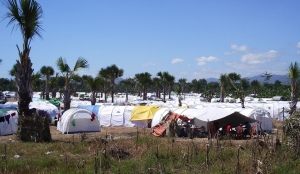
Refugee Camp, Dili 2006 – Photo by Austcare
www.flickr.com/photos/austcare
But how to exist as a Timorese institution? First he tried to convince the board of directors to engage with the business, but not one director was willing to meet with him. A quarter of the staff left for more secure jobs in the government. But Angelo felt he had to try and make it work. It was for his community and his young country.
The remaining staff forged a plan to manage the budget to make it work. Cuts came, and they were difficult, but there was a desire to make sacrifices to rebuild. Benefits were cut to the bone. Employees agreed to sleep in branch offices to save on lodging expenses while traveling. TRM leased one of the cars to another company. Tightening their belts, they managed to reduce expenses significantly.
There were a few challenges in helping their clients rebuild. First the 2,800 clients had to be found amid the refugee camps. Micro-finance, by its nature, is a labor intensive business. The loan officers spend a lot of time out in the community getting know their clients personally, and they meet with them when loan repayments are made. They were accustomed to doing a lot of leg work, and clients were found.
Loans were restructured, and, in many cases, additional loans were made available. It took about a month to get most businesses going again, but most did get going again. The challenge was helping clients rebuild while keeping the company afloat.
A Bumpy Road
Things were going so well that in March of 2007 TRM opened a new field office in Lospalos, Lautém District. And in May income met expenses for the first time since TRM became a Timorese business – just five months after CRS pulled out.
Working closely with their clients, they set the stage to reduce the number of delinquent loans from 75% in 2006 to only 14% in 2009.
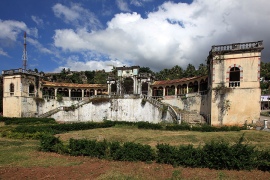
Villa Salazar, Baucau
http://www.flickr.com/photos/peace-on-earth_org/5939317518/
But inconclusive June 2007 elections between seven competing parties and protracted negotiations to come up with a ruling coalition led to political unrest. Generally, there was an East-West divide of feelings. Those in the east generally favored independence parties, while those in the west leaned toward Indonesia.
Most people were fearful of leaving their own cities. But Angelo continued to make the run between Dili (west) and Baucau (east) on a regular basis to keep the business moving.
In July there was a month-long work stoppage in Baucau. Banks and government offices closed. All activity stopped. But not at TRM. In order to keep a low profile, the loan officers visited their clients on their motorbikes dressed in shorts and sandals and, when challenged, said they were out visiting friends. There were no banks to deposit their collections, and they avoided using the office, so the Branch Manager kept loan collections in his house.
The political unrest turned violent in several districts, including Baucau. On July 7 TRM’s Baucau branch office was burned along with all the records. $18,000 in cash was lost.
Stability …. at Last
Since the mid-decade troubles, the political climate has been much more stable. UN security forces moved in to stabilize the country, and they just left in December, 2012.
TRM has been on a steady growth path with help from BASIX and the UNCDF (UN Credit Development Fund) and now serves over 7,500 clients in all 13 national districts. The loan portfolio has grown to over $2.8 million. They offer a complete portfolio of loan products, micro-insurance and deposit savings accounts.
Tuba Rai Metin has been a partner with Kiva since May of 2012, offering the opportunity for Kiva lenders to make loans directly to individuals and groups served by TRM.
I am in Dili working with TRM to solidify and expand the relationship with Kiva. Angelo and his team have just completed the requirements to move from “pilot” to “active” status. This will increase the amount of money Kiva makes available to lend to TRM borrowers through the Kiva website, as well as open the door to fund special development projects.
I hope you will look for TRM’s clients on Kiva.org as you search for places to connect with small entrepreneurs.
Phoenix or Mortal?
The phoenix resurrected from its ashes is a fanciful image created in men’s minds. The origin of the story is lost in time. Perhaps it was used as soothing encouragement during catastrophic times. Maybe an inducement to rise powerfully against a conquering enemy.
To stand firmly on the ground is something humans do. In the final analysis, it is the only course of action we humans have. But we can do pretty well. Perfecting our stance will do more to help ourselves and others than any flight of fancy.
Introducing Timor-Leste
I arrived in Timor-Leste about a week ago to begin a Kiva Fellowship, and you might be wondering where the heck that is. So I’ll try to fill you in on some background while I ease into the place.
I like maps. Here’s one of the world:
The Regional Context – Southeast Asia
I’ve traveled through SE Asia quite a bit, and I really like the region. It is exotic. Some places are truly Paradise – there are apples, serpents and even the occasional sinner seeking (or transferring) knowledge.
A few cities are westernized and modern, and it’s hard to remember you’re in Asia. But most places have a very different feel. The various cultures have lived in relatively close proximity for… well, forever, but travel has been difficult, so there are still very diverse regional identities – language, food, beliefs, traditions, even the weather.
The region has seen empires come and go, waves of invaders and colonists, been in the middle of world conflict, and shared in more peaceful cross-cultural exchanges as international trade has blossomed. But some places are still nearly untouched.
Hang On, Another Map Is Coming
Even if you haven’t been to the area, or can’t find them on a map without searching a bit, you have heard the names. The Asian Tigers – the economic tigers – of Singapore, Brunei, Malaysia, Thailand and Indonesia have done well in the global economy.
Like the rest of the world, income and wealth distribution is very uneven. The per capita GDP’s of Singapore (intellectual and manufacturing hub) and Brunei (think oil) are higher than the USA. Malaysia, the third largest regional economy, earns 1/3 the US figure. Thailand’s is half of that. Indonesia, with a roaring economy (16th largest GDP, and the fourth largest world population) has a per capita GDP that is half of Thailand’s – one tenth that of the US.
Malaysia, Thailand and Indonesia are rich places for some people, but poor for most.
Timor-Leste – the first new country of this century – ranks nearly last, economically. Among all of Asia, its 2011 per capita GDP of US$4.50 per day (3% of the US figure) places it just ahead of Myanmar, Afghanistan and Nepal, and just behind Bangladesh. And this figure is inflated due to the large UN and non-governmental organization (NGO) presence, of which I am a part. It also includes oil wealth which is the only means the government has to fund itself.
More maps:
Here Comes Some History to Complement the Geography
Partly due to history, but perhaps mostly due to geography Timor has always been a backwater. The island is the 5th largest of the 17,000 islands making up the Indonesian archipelago and is near the far eastern end (almost in Papua New Guinea). About the size of Massachusetts, or a bit smaller than Belgium, it never figured very large in Dutch or Portuguese colonial ambitions. There wasn’t much to take except sandalwood – the only place on earth where sandalwood forests exist today.
The only lasting legacy the Europeans left behind was the political division of the island into east and west (and some influence on the local language). The Dutch on the west end of the island had a toe hold in Kupang, and the Portuguese in the East at Dili. Their colonial administration centers were just too far away to care – the Dutch were in Jakarta/Batavia 1200 miles to the west; the Portuguese center in Malacca on the Malay Peninsula was even farther.
Fast Forward a Few Centuries
A major consequence of Japanese expansion in WWII was the dismemberment of European colonial control. Local populations were startled at how easily the Japanese swept out their oppressors. So, after the war independence fever hit the region defying European return – Malaysia, Singapore & Burma/Myanmar (British), Vietnam & Cambodia (French), Philippines (US), and Indonesia (Dutch) ultimately became independent nations.
When the Dutch formally acknowledged Indonesian independence in 1949, the western end of Timor went with it.
Independence for the East? …. Not Yet
The eastern end of the island remained in Portuguese hands until the 1974 military coup (Portugal’s “Carnation Revolution”) ousted dictator Antonio Salazar and brought democracy to Portugal. One reason for the coup was continued conscription to fight wars in the colonies.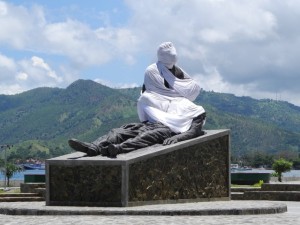
But 1975 did not bring freedom to East Timor. Indonesia had ambitions on the entire island and the absence of the Portuguese and lack of international interest allowed them to enforce a long and bloody occupation. There were pro- and anti-Indonesian militia factions warring among themselves, civilian massacres of thousands and a civilian exodus of hundreds of thousands. A 1997 Asian financial crisis increased social unrest prompting the UN to send peacekeepers (mostly Australian). In 1999 a referendum on independence only fueled factional violence.
Independence!!
Independence was finally achieved in May of 2002 – Repúblika Demokrátika Timor-Leste becoming the first new nation of the 21st century. But internal rankling and a presidential assassination attempt kept the country in an anxious state into 2008. The UN just left in December of 2012 after a long transition of security control to local forces.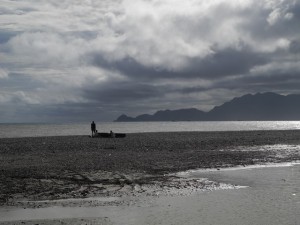
Timor-Leste is poor and always has been. Today, oil and gas account for half the exports. Coffee – Starbucks buys 80-90% of it – makes up a quarter. There’s a small traditional crafts industry, and a small tourist market – mostly for Scuba divers plunging into the rich waters just offshore (you can drive to some nice dive spots).
But most of the population live as subsistence farmers. You remember that $4.50 per day per capita GDP (which includes oil and gas exports)? Well, about 70% of the population earns less than $2 per day.
And that is why Kiva has sent me here.
Specifically, I’m working with a local micro-finance institution called Tuba Rai Metin. In the local Tetun language that means “Stand Firmly on the Ground” which is an apt monicker for only one of two micro-finance institutions to adapt to, evolve and survive the violence and uncertainty of the last decade. From its beginning in 2001 with support from Save the Children Federation it has grown to have a loan portfolio of about $5M serving 7,000 borrowers (all women) and offers financial products such as business and agricultural loans, micro-insurance, and deposit savings.
You’ll be hearing more about this.
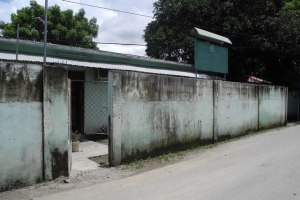
Headquarters – Tuba Rai Metin http://www.tubaraimetin.com/
Getting Ready to Go!
Thankfully the Mayans were wrong and I’m here to write my first blog of the 13th year of the third millennium.
I was recently in San Francisco for a week-long training course with 25 volunteers for Kiva.org – the internet based, peer-to-peer microfinance lender. We are the 20th class of Kiva Fellows.
Kiva’s prime mission is to alleviate poverty by making credit available to poor people. Kiva loans interest free money to microfinance institutions (MFI’s) throughout the world. Kiva Fellows work with the MFI’s to help them meet Kiva’s requirements as they loan to poor people in their communities.
Much of the training was as expected – accounting reporting requirements for MFI’s, information MFI’s need to collect and post on Kiva’s website, communications, how to use the website, how to take interesting photos/videos, where to go for needed information, etc.
The inside view of how a charity organization works was the most interesting part of the training sessions. Coming from the profit-driven world, it was quite a mind-blowing experience to be discussing how to reach poor people with very high credit risks who may not pay back their loans … and reduce the tendency to loan to less risky borrowers. The term “risk averse” does not apply.
But the best part of the experience was interacting with the group of Fellows. Most were younger than me (it is getting harder to find groups that are NOT younger than me). It was an international group – all had spent time or lived in some part of the world other than their homeland. All had a tremendous knowledge of the world and a well-developed perspective of their place in it. It was really refreshing to meet them and participate in the group training sessions to see and feel the energy they bring.
Many of the Fellows have already arrived in their work countries, and I will be deploying to Timor soon. I’ve raised enough money to cover my flights, but I’m still trying to raise money to cover four months of living expenses. Please check out my fundraising site at indiegogo and help if you can!
 www.indiegogo.com/becklectic1/x/1890065
www.indiegogo.com/becklectic1/x/1890065
More blogs to follow once I get on the ground in Timor!

